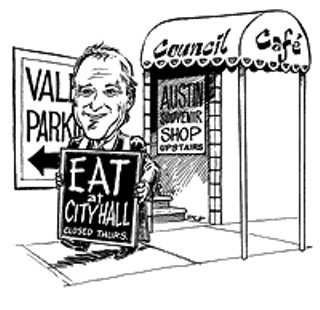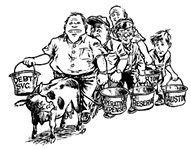Council Watch
Council reluctantly approves retail in the new city hall, with the stipulation that there be no gaudy storefronts on Second Street.
By Kevin Fullerton, Fri., June 16, 2000

Selling City Hall?
In all the heady excitement aroused by visions of our very own Main Street, USA, right here in downtown Austin, the prospect of a bustling retail strip along West Second has been as tantalizing as the smell of freshly ground coffee. But the debate over whether the new City Hall, which will be sandwiched between those rows of storefronts, should itself house a restaurant and shops has served City Council members a sobering reminder: There's the idea of retail, and then there's the thing itself, all glossy signboards and blinking lights. At last Thursday's meeting, council members reiterated their demands that the façade of the structure built to house the solemn proceedings of city government not be decked out like an urban mall.
City redevelopment staff agreed with retail developers that the Main Street concept won't work unless all parts of the strip invite commercial activity. But other voices continue to question the recent decision to expand City Hall to provide retail space, suggesting that developers are trying to pry square footage from the city that they didn't get from Computer Sciences Corporation, whose new office towers will house much of the strip on Second.
In the Thursday morning session, the council approved adding 15,000 square feet to the future City Hall, including 4,000 square feet for a restaurant and "other support uses for users and visitors," along with a 750-car parking garage. But by that afternoon, council members had brought the item back for discussion, worried that staff in Redevelopment Services hadn't read their lips: No commercial storefronts facing Second Street. At the behest of Council Member Daryl Slusher, the council passed an amendment to the morning resolution requiring staff to present a design option that would not advertise retail activity on the building's exterior. Slusher said he feared that the high-visibility retail concept would be the only option offered when staff presents design proposals, probably toward the end of the year. "I'm worried that when this comes back, this will already be rolling down the track, with retail on the front of City Hall," Slusher said.
But Jan Hilton, the Redevelopment Services official overseeing City Hall, said glitzy exteriors aren't the only way to advertise retail. She said outside cafe seating, benches, and other attractions could do the trick, too. "I think it can be tastefully done," Hilton said. She says experiments with retail in other public buildings, notably the City Hall in Portland, show that businesses requiring substantial capital outlays haven't done well without exterior advertisement. "If there's no outside presence, we'll have to change the options," says Hilton. "We may not get the kind of retail we wanted" -- a restaurant, and perhaps a city souvenir shop.
It's also true, however, that the push for retail in City Hall is driven partly by the fear of prospective retail developers that the commercial zone along Second and Cesar Chavez streets, which could include about 180,000 square feet of retail on the blocks occupied by CSC and the proposed AMLI apartment building, is barely massive enough to generate a magnetic draw on customers. The new Austin MarketPlace near Sixth and Lamar, by comparison, contains nearly a half-million square feet.
"It seems like some of the pressure for putting retail in the City Hall is coming because it may not have been accommodated as fully in the CSC projects as some of the consultants would like to see," suggests Phillip Reed, an architect with the local firm managing the City Hall design, CKNR Architects. CSC project coordinator Nathan Schneider counters that CSC came through with all of the retail space originally envisioned when the city began discussing Second Street redevelopment with the company.
Stuart Shaw, representing one of two companies vying for the right to develop the new commercial corridor, AMLI/Bonner Carrington, doesn't deny that every square inch of available space is needed to make the Main Street vision feasible. Shaw says he isn't sure what the critical mass for the project is, but "more is better," and a contiguous layout is crucial, when it comes to engaging pedestrians. "To the extent we don't do that, we risk the legitimacy of the entire district because it takes a synergistic mass to be successful," says Shaw. At Thursday's meeting, Mayor Kirk Watson threw his support behind a retail presence at City Hall, saying that citizens who come to discuss public business deserve a building with a place to eat and congregate. Hilton says the city hopes to choose a retail developer to spearhead the Second Street project by August.
Cops and Conservation
In other action, the council agreed to pay over $10 million to prevent development on an environmentally sensitive tract in northern Hays County owned by Rutherford Ranch. The city committed about $5.5 million from proceeds raised in the May and November 1998 bond elections, but hopes the private sector will help pay the balance on the tract, which is estimated to gather about 15% of the water that flows through Barton Springs pool.The council also ordered City Manager Jesus Garza to include the recommendations of the Police Oversight Focus Group, including the enforcement of civilian oversight of the Austin Police Department, in the meet-and-confer negotiation process currently ongoing with the Austin Police Association.
This Week In Council
The newest incarnation of the City Council will become a reality today, Thursday, June 15, at the 7:30pm swearing-in ceremony in Ballroom A at the Austin Convention Center. Newly elected members Raul Alvarez, Will Wynn, and Danny Thomas, along with Mayor Watson, will take the oath of office. Afterward, Council Member Jackie Goodman is expected to be re-elected as mayor pro tem.
Got something to say on the subject? Send a letter to the editor.








